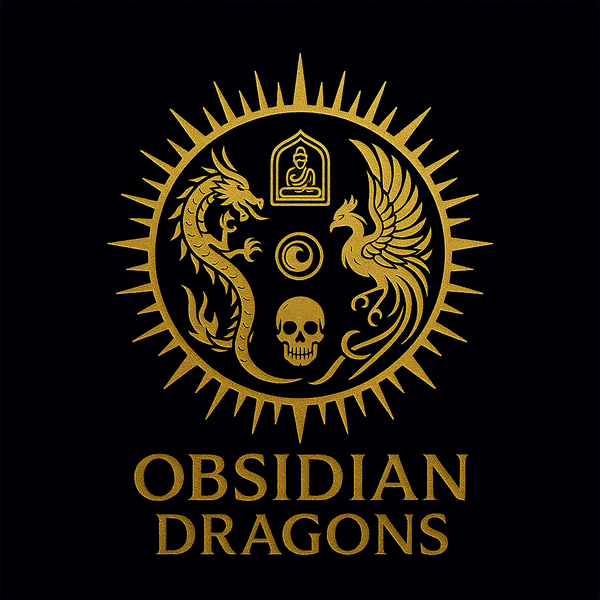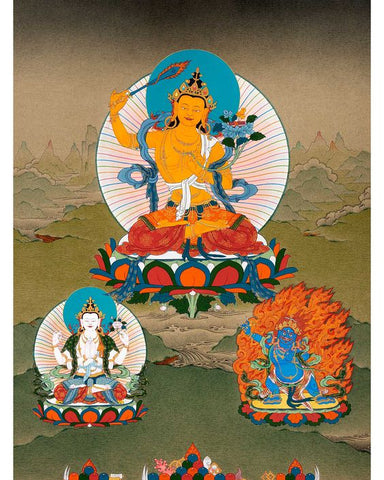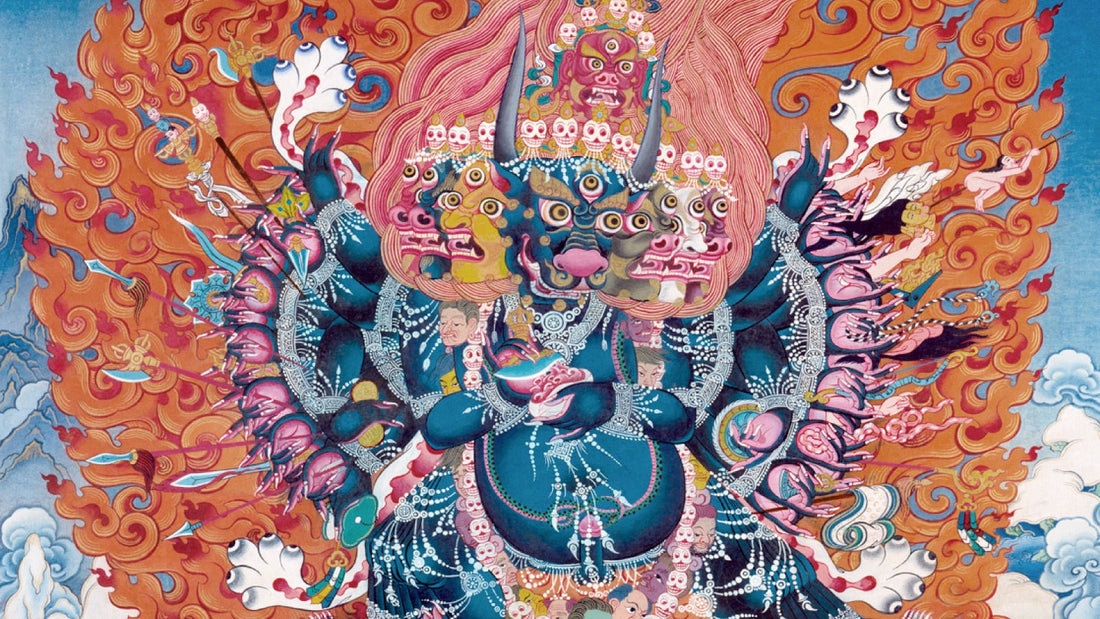
Yamantaka - The Destroyer of Death
Share
Yamantaka is an important tantric deity in Tibetan Buddhism , a central deity of Vajrayana Buddhism, Yamantaka is referred to as the "destroyer of death".
He is described as the "conqueror of the lord of death".
This Sanskrit name consists of two main parts:
" Yama ", which represents the god of death, and
" antaka ", meaning destroyer.
Thus, Yamāntaka is interpreted as "destroyer of death", "executioner of death" or "one who puts an end to death".
Yamantaka is considered to be a manifestation of Manjushri, the bodhisattva of wisdom, in a wrathful form.
Manjushri embodies non-dual wisdom, ending the fragmented duality of phenomena caused by ignorance. Emanating from the primordial base, phenomena are inherently unborn. However, under the influence of ignorance and attachment to the "self", they emerge as samsara and nirvana. Under illusion, they manifest as compound and impermanent phenomena, subject to birth and death. To transcend this illusion and death, Manjushri assumes the formidable form of Yamantaka. This reveals the wisdom of emptiness and synthesizes the play of the many into non-duality.
Yamantaka then swallows up in the dharmadhatu, without any exception, all the troops of death which devour the three worlds.
(Text taken from the collection "precious basket of precepts, Upadesa rin-po-che za-ma-tog).
2- Genesis of Yamantaka
Considered as a cultural heritage of the Hindu deity Kalantaka, one of the emanations of the god Shiva, who delivered his disciple from the clutches of death Yama, and, is considered as the deity at the origin of the Mahamrityunjaya Mantra, both in Buddhism and Hinduism.
This assimilation can be seen as an incorporation of pre-existing religious concepts and figures into the Hindu tradition, where they are reinterpreted and adapted to align with Buddhist teachings and practices.
In the case of Yamantaka, this assimilation adds a symbolic and spiritual dimension to this deity in the context of Vajrayana Buddhism, where Yamantaka represents the transcendence of death and the attainment of enlightenment.
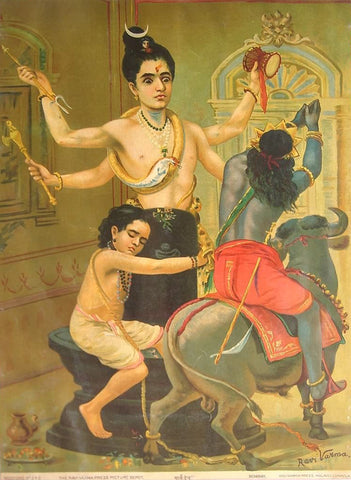
His depiction has many parallels with Yama, the Hindu god of death: often riding a buffalo and often depicted with a bovine head. Because of this resemblance and the similarity in name, it is common to find texts confusing Yamāntaka and Yama as the same deity, although they are distinct.
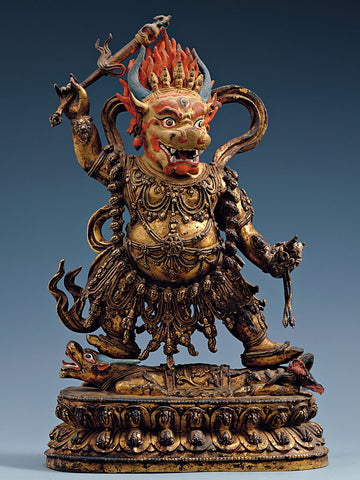
3- Meaning of “ending death” in Buddhism
In Buddhism, the idea of "ending death" does not refer to a physical cessation of death, but rather to a cessation of the cycle of rebirth, or samsara, leading to ultimate liberation or enlightenment: nirvana.
In Buddhism, the cycle of rebirth is considered to be fraught with suffering. Liberation from samsara means escaping this endless cycle of birth, life, death, and rebirth. It is the ultimate cessation of suffering.
Ending death is associated with the attainment of enlightenment or awakening. It is the state of full awareness and deep understanding of the nature of reality, which transcends the limitations of body and mind.
In Buddhism, death is seen as the result of attachment to the ego and the illusion of the self. Ending death involves transcending this egoistic attachment and realizing the illusory nature of the self, leading to liberation from suffering.
Ending death is not only an individual achievement, but also a commitment to universal compassion. Great Vehicle or Mahayana Buddhists who attain enlightenment are expected to return to samsara to help others attain liberation as well, thereby sharing their wisdom and compassion.
The bodhisattva renouncing his own liberation to remain in the cycle of rebirth in order to help others attain enlightenment is the essential concept of Mahayana or Vajrayana, in contrast to Theravada or lesser vehicle Buddhism, which emphasizes primarily the pursuit of individual liberation.
Thus, Yamāntaka embodies both the goal and the practitioner's journey toward enlightenment. At ultimate awakening, one manifests Yamāntaka - the cessation of death.
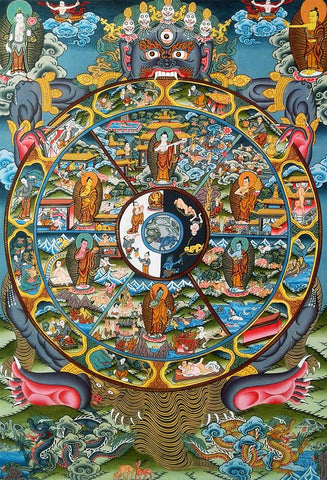
4- Yamantaka in the tantra texts
In esoteric circles of Buddhism and Hinduism, the term "tantra" refers to a category of texts and practices associated with secret practices.
These texts contain teachings and rituals that aim to transcend the ordinary limits of human consciousness to reach higher states of consciousness.
Tantric practices often involve intense visualizations, chakra meditations, and sometimes even rituals involving sexual partners, but in a strictly spiritual and sacred context.
An example of a tantra text in Buddhism is the "Guhyasamaja Tantra". This text presents teachings on meditation, mandala visualization, tantric practices, and the union of wisdom and compassion. The Guhyasamaja Tantra is considered one of the foundational texts of Vajrayana and is revered by tantric Buddhist practitioners for its profound teachings on the nature of reality and the path to enlightenment.
Some of the major tantra texts relating to Yamantaka in Tibetan Buddhism include:
-
Guhyasamaja Tantra : This tantra is one of the foundational texts of Tibetan Tantric Buddhism. Yamantaka is often considered a primary deity in Guhyasamaja practice.
-
Yamantaka Tantra : This is a specific text dedicated to Yamantaka. It contains detailed teachings on the practice of this deity, including his forms, mantras and mudras.
-
Chakrasamvara Tantra : Although this text is primarily focused on the deity Chakrasamvara, Yamantaka is also present in certain practices associated with Chakrasamvara.
-
Vajrabhairava Tantra : Yamantaka is also revered as a form of Vajrabhairava, and this tantra contains instructions on the practice of Vajrabhairava, which often include aspects of Yamantaka.
In the Kangyur, the canonical collection of Tibetan Buddhist scriptures, there are also texts related to Yamantaka. Some of the important texts include:
-
Yamari Tantra: This text describes the tantric practices associated with Yamantaka, including its forms, mandalas, mantras, and rituals.
-
Yamantaka Puja : These texts include prayers, meditations, and practices dedicated to Yamantaka. They are used in Tibetan religious rituals and ceremonies to invoke Yamantaka and receive his protection and blessings.
-
Yamantaka Sadhanas : Sadhanas are guided meditation practices that include visualizations, mantra recitations, and other specific rituals. Several Yamantaka sadhanas are included in the Kangyur for Vajrayana practitioners.
Among the 18 Mahayoga tantras, which are an important part of Vajrayana, some include teachings and practices related to Yamantaka:
-
Guhyagarbha Tantra : This tantra presents teachings on the fundamental nature of the mind and the transformation of emotions into wisdom. Yamantaka is sometimes mentioned in the context of these practices.
-
Vajrapanjara Tantra : This tantra emphasizes the purification of obstacles and the attainment of clarity of mind. Yamantaka can be invoked in the practices described in this text.
-
Vajrapanjara Yamantaka Tantra : This specific tantra is dedicated to Yamantaka and contains detailed instructions on the practice of this deity, including his forms, mandalas, mantras and rituals.
-
Sarvadurgati Parishodhana Tantra : This tantra aims to purify karmic obstacles and dispel illusions. Yamantaka is sometimes invoked as a protective force in these practices.
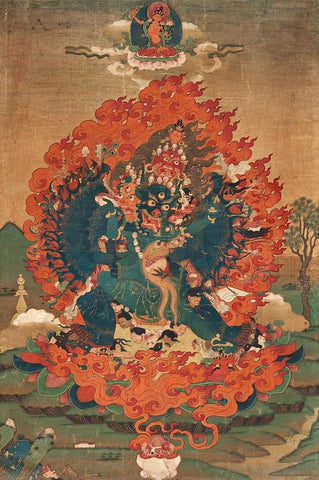
5- The manifestations of Yamantaka
There are a multitude of manifestations of Yamantaka, but five of them are considered essential.
Manjusrikaya (Tib: Jam-dpal-sku):
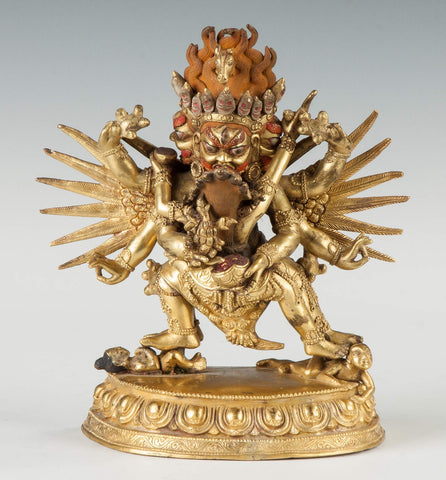
"Manjushri, the body deity" of the Kagye in the Nyingmapa school, is represented in the form of a heruka with three heads, six arms and four legs. Its color is dark yellow, with a white face on the right and a face red on the left. On his right he holds a vajra, a sword and a war axe (or a ewer), and on his left he makes a threatening gesture (or holds a skull cup), a noose (or an arrow ) and a skull cup filled with blood. He is depicted trampling a male demon and a female demon, with outstretched vajra wings, and is united with a black vetali. His mandala includes fifty-eight deities.
There is also a blue form of Manjushri (with a white face on the right and a red face on the left), holding a wheel, a sword and a vajra in his right hands, brandishing a club and pestle in the left, and making a threatening gesture with the last hand.
Yamantaka or black Yamari (Tib: Shin-rje-gshed nag po) 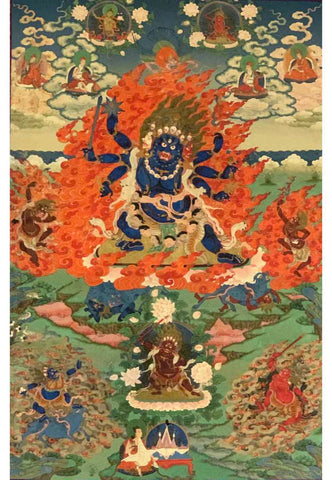
This manifestation of Yamantaka can take different forms: one face and two arms, one face and six arms, three faces and four arms, or three faces, six arms and six legs. Its distinctive attributes include the vajra-tipped staff and the shoelace, and it is united with Vajravetali.
Red Yamari (Tib: Shin- rje- gshed dmar- po): 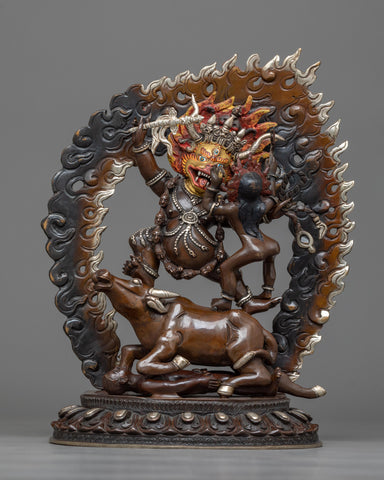
Yamantaka appears in a single form with one face and two arms. In an extremely wrathful state, adorned with all the macabre attributes, he stands with his legs spread to the right on a red buffalo, above a sun disk.
His right hand brandishes a skull stick, while his left hand holds a skull cup filled with blood.
He is united with Red Vetali, holding a curved blade and a skull cup filled with blood.
Both are surrounded by flames.
Vajrabhairava (tib: rDorje 'jigs- byed) Adamantine Terror:
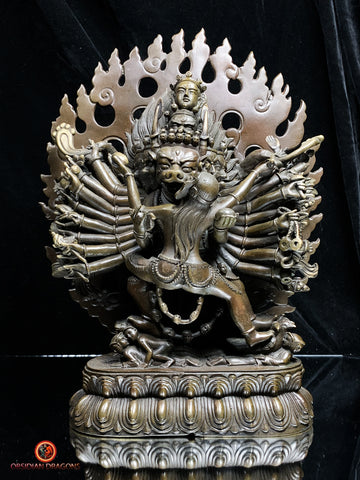
This form of Yamantaka is one of the principal deities of the ancient and recent father tantras, particularly venerated in the Sakya and Gelugpa schools.
This form is complex, with nine heads, thirty-four arms and sixteen legs. Topped with the peaceful yellow head of Manjushri, an angry red head emerges from the central head of the blue-black buffalo. On the right are three faces - yellow, blue and red - and on the left are three more - dark red, white and dark green.
Its massive blue-black body is adorned with a garland of fifty skulls and bone ornaments. Its multiple arms are laden with attributes: cleaver, phurba, peacock feathers, pestle, razor, spear, hatchet, javelin, arrow, iron hook, skull staff, khatvanka, cogwheel, vajra, hammer, sword, damaru and elephant skin on the right; and skull cup filled with blood, fourfold head of Brahma, shield, foot, lace, bow, entrails, bell, arm, piece of shroud, impaled man, dharmodaya (triangular box), skull cup, mudra of threat, trident, banner and elephant skin on the left.
Its sixteen feet trample animals and figures, each carrying its own meaning. On the right, a man, a buffalo, an elephant, a donkey, a camel, a dog, a sheep, a fox, under which are the gods Brahma, Indra, Rahula and Rudra. On the left, a vulture, an owl, a crow, a parrot, a falcon, a heron, a rooster and a swan, under which are Kumara, Ganesh, the sun and the moon.
Yamantaka is united with his mystical wife Vajra Vetalî blue and sits enthroned on a lotus with a sun cushion, surrounded by a terrible blaze.
Each attribute, each detail of this form is charged with a precise meaning:
- Nine Heads : Represents the ability to perceive the nine basic emotions simultaneously, as well as the transcendence of these emotions to achieve a state of equanimity.
- Thirty-four arms : Symbol of omniscience and the ability to perform many beneficial actions simultaneously.
- Sixteen Legs : Represents stability in all situations, as well as the ability to move quickly to rescue beings.
- Yellow Head of Manjushri : Represents transcendent wisdom and ultimate knowledge.
- Irritated red head emerging from the central head of the blue-black buffalo : Symbolizes righteous and controlled anger, used to destroy ignorance and obstacles to awakening.
- Three faces on the right (yellow, blue and red) : Represent the three bodies of the Buddha (reality body, enjoyment body, emanation body) and the three poisons of the mind (ignorance, desire, aversion).
- Three faces on the left (dark red, white and dark green) : Symbolize the three benevolent activities of body, speech and mind for the benefit of all beings.
- Garland of Fifty Skulls and Bone Ornaments : Evokes the transcendence of the fear of death and the realization of the emptiness of all phenomenal form.
- Multiple arms on the right : Carry various attributes that represent the destruction of negative forces and the establishment of enlightenment, as well as the protection of practitioners.
- Multiple arms on the left : Represent the offering of blessings and benefits to practitioners, as well as the purification of negative emotions.
- Trampling feet of animals and people : Symbolizes domination over negative forces and obstacles, as well as protection of practitioners.
- Union with Blue Vajra Vetalî : Represents the unity of transcendent wisdom (Vajra) with primordial energy (Vetalî), leading to complete awakening.
- Throne on a lotus with sun cushion : Evokes purity and transcendence of all dualities.
- Surrounded by a terrible blaze : Symbol of the purification of disturbing emotions and obstacles to awakening.
Daiitoku Myoo, Yamantaka in Japanese Shingon Esoteric Buddhism: 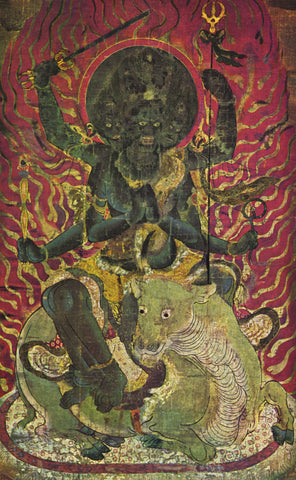
In Japanese Tantric Buddhism, Daiitoku Myoo appears alone, filled with wrath and enveloped in flames. Seated on a buffalo, he has six arms and six legs. Two of his hands perform the mudra of crushing evils, while the others hold a vajra sword, a staff, a trident and a wheel. He is included in the group of the wrathful "five great kings of light" of the Garbhadhatumandala.
In Shingon, he is considered a representative of Vajradhara Buddha, the primordial form of the Buddha.
He embodies the transcendent wisdom that destroys ignorance and obstacles on the path to enlightenment.
In Shingon practice, Daiitoku Myoo is revered as a powerful protector against negative forces and malevolent influences. Followers use his teachings and rituals to overcome inner and outer obstacles on the path to spiritual realization.
6 - Yamantaka Mantra:
The main mantra associated with Yamantaka is:
“Om Vajra Berotsana Yamantaka Hum Phat”
Om: is a sacred and symbolic sound used in several spiritual traditions, including Hinduism, Buddhism, and Jainism. It is considered the primordial sound of the universe, representing universal creative energy and ultimate reality.
In these traditions, "Om" is used as a sacred seed syllable when meditating, reciting prayers, or performing rituals. It is believed to embody the concepts of unity, connection, and transcendence beyond the confines of the individual ego.
Vajra: Vajra refers to a powerful and sacred symbol in Buddhist and Hindu traditions.
often translated as "diamond" or "lightning" and symbolizing indestructible strength, clarity of mind, and the indestructible nature of ultimate reality. It also represents compassion and awakened wisdom.
In the context of the Yamantaka mantra, "Vajra" can be interpreted as invoking the strength and clarity needed to overcome obstacles and achieve enlightenment, while also symbolizing the indomitable nature of Yamantaka itself.
Berotsana: Sacred syllable is considered as a bija mantra, that is, a seed syllable or sacred sound which possesses a particular spiritual energy.
Each bija mantra is associated with a specific quality or aspect of the deity being invoked. In this case, "Berotsana" is an integral part of the Yamantaka mantra and helps invoke its power, protection and wisdom for practitioners.
Yamantaka: refers to the primary deity that is invoked. Represents the power, protection and wisdom of that deity. Reciting his name in the mantra is intended to invoke his beneficial energy, purify the mind and establish a spiritual connection with that deity with the aim of attaining enlightenment and ultimate liberation.
Hum: Sacred Sanskrit syllable used in Tantric Buddhist mantras, associated with purification and transformation of negative emotions into wisdom. Also considered a symbol of the nature of pure mind and emptiness.
In the context of this mantra, "Hum" enhances the power and effectiveness of Yamantaka's invocation, helping to purify the mind and establish a deep connection with the wisdom and compassion of this deity.
Phat: Also a sacred Sanskrit syllable used in Tantric Buddhist mantras, "Phat" is interpreted as an expression of power or energy. It is a syllable used to seal the mantra, thus strengthening its effectiveness and protection.
"Phat" is considered to be a manifestation of the strength or power of the deity invoked in the mantra. Its final use in the mantra is as a means to quickly manifest the blessings and protection of the Yamantaka deity.
